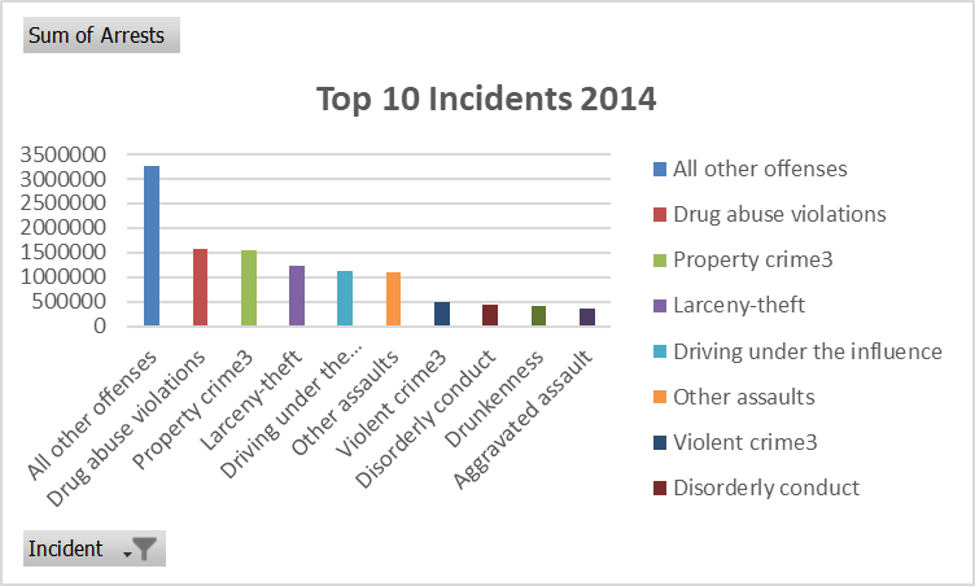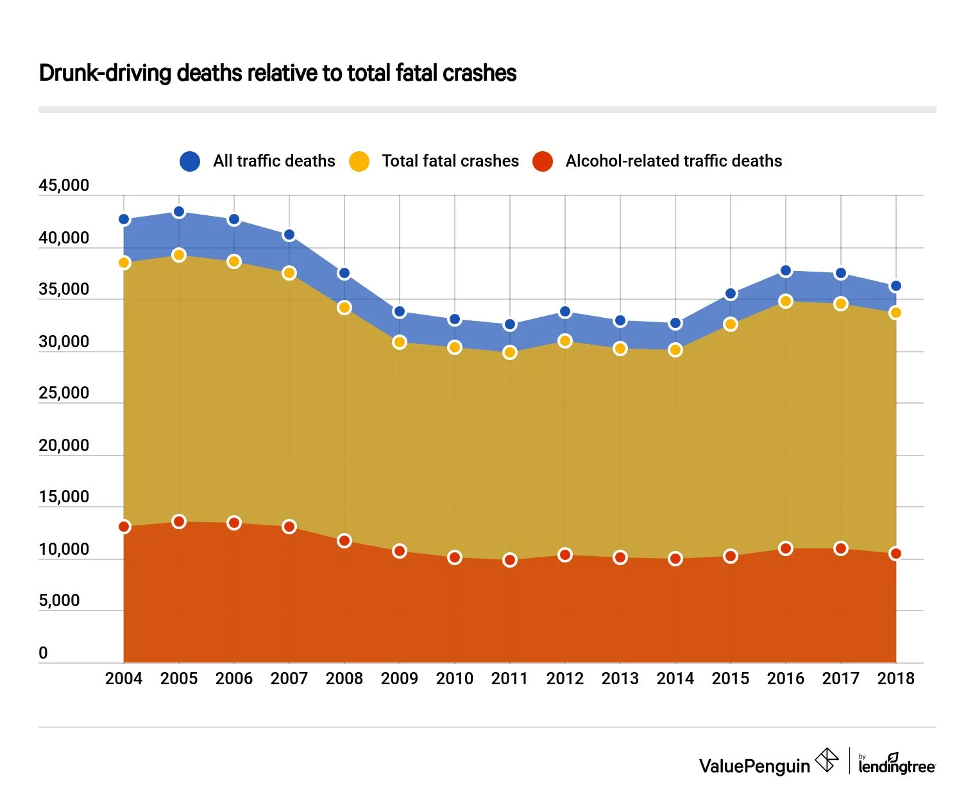INTRODUCTION
According to the National Highway Traffic Safety Administration, thirty-two people in the United States lose their lives every day in accidents related to drunk driving. Broken down further, it shows that, on average, approximately one person dies every 45 minutes due to drunk driving crashes. The Federal Bureau Investigators reports show that in 2014, 11,540 people lost their lives in drunk-driving-related traffic accidents (“Drunk Driving,” para. 3). Notably, all these deaths were preventable had the correct measures been taken by both the drivers and the institutions involved in controlling drunk driving.
Drunk driving is a menace that affects not only the USA but countries all over the world. Given the statistics that a drunk driver would have probably driven while drunk over 80 times before facing their first arrest show how severe the drunk driving problem is (“Drunk Driving,” para. 1). I will analyze this statistic and its implications in this statistical analysis paper. I will also suggest preventive measures that would improve road users’ safety by reducing drunk driving incidences if put in place.
STATISTICS ON DRUNK DRIVING

The statistics that drunk drivers would probably have driven over 80 times before facing their first arrest are concerning. The statistics show that drunk driving is common among many drivers and is not just an isolated behavior (“Drunk Driving,” para. 1). This is concerning since drunk driving can cause severe accidents, which would result in many casualties.
The Mothers Against Drunk Driving (MADD) report indicates that the current measures to prevent drunk driving are insufficient since it would take several instances of drunk driving for a driver to be arrested. The report shows the great need to reassess the preventive measures and develop more effective ones to help curb drunk driving.
According to the FBI’s Uniform Crime Reporting (UCR) Program, highlighted in the statistics, in 2014, 9.9 million arrests were made in the United States. The graph in Figure 1 above shows a breakdown of the incidents with the highest number of arrests broken down by category (“Table 29: Arrests by State, 2014”). Drunk driving had the fourth highest number, with 1117852 arrests. This is a significantly increased number; however, it is just a fraction of the incidents identified by law enforcement agencies. Another fraction could drive while under the influence but was missed and still posed a danger to themselves and other road users.
Several factors contribute to the delayed arrests of drunk drivers. Despite the efforts made by law enforcement agencies to crack down on drunk driving, the number of law enforcers on the road is relatively low to combat the drunken driving menace fully. It is also challenging to identify drunk drivers since some do not show visible signs of being drunk; therefore, law enforcement officers would have a hard time detecting them. Another factor contributing to the late arrests is the lack of reporting by the public (Rahman and Islam, 2). Many drunk drivers go free since some probably do not understand the danger posed by drunk drivers or because of fear of retaliation. Some drunk driving repeat offenders have also mastered the art such that law enforcement officers would hardly realize they are drunk.
From the report by MADD, public awareness campaigns, improved law enforcement, and more strict penalties for offenders are some preventive measures that could help reduce drunk driving incidents in the USA. The use of Technology such as ignition interlock, which prevents vehicles from starting in case the drivers are drunk, is also suggested in the report as a measure that would help to control the number of drunk driving incidents. Other research has also shown that using such technology would be very effective in lowering the cases of drunk driving (Kaufman and Wiebe 15).
The report by MADD further suggests that multifaceted approaches, which would involve collaboration among law enforcement agencies, community organizations, as well as policymakers, can significantly help to come up with measures that would work to reduce cases of drunk driving (“Drunk Driving,” para. 5). Education of the masses about the dangers which are associated with drunk driving would also be effective in reducing the cases of drunk driving.
In summary, the statistics that an averagely drunk driver would have driven more than 80 times before facing an arrest, as shown in the report, is troubling and indicates the prevalence of this behavior, which is very dangerous.
DANGERS OF DRUNK DRIVING

According to the report by ValuePenguin, “Drunk Driving Statistics,” (para. 6), as shown in Figure 2. above, in 2014, it is estimated that there were 9,967 alcohol-related traffic deaths, which was a slight decline compared to 2013, where there were 10,076 alcohol-related traffic deaths (“Drunk Driving,” para. 4). This shows how severe drunk driving is and the danger it poses to road users, both the drunk driver and other people on the road.
From the report by the National Highway Traffic Safety Administration (NHTSA), drunk driving contributed to 31 % of all traffic fatalities in the USA in 2014. The deaths could have easily been prevented had the drivers not driven under the influence of alcohol. NHTS also reports that alcohol-related crashes cost the United States government $44 in 2014. The costs are associated with medical expenses, lost productivity, property damage, and emergency services.
Therefore, it is imperative to put preventive measures in place to help curb the drunk driving menace. The measures to curb drunk driving would fall on not only the government but also individuals who are the ones that engage in the dangerous behavior.
PREVENTIVE MEASURES
A number of preventive measures have been implemented by countries worldwide to curb the drunk driving menace. Some measures include ignition interlock devices, as was stated before, DUI checkpoints, and breathalyzer tests (Kaufman and Wiebe 20). In this section of the report, I will analyze some measures that can be implemented to reduce the number of drunk driving fatalities and drunk drivers on the road.
The first measure to reduce drunk driving is to increase public awareness. Educating the public on the dangers drunk drivers pose to road users would help reduce drunk driving cases. The Education would help individuals who have engaged in drunk driving realize its dangers and refrain from the behavior. It would also help educate the public on reporting drunk driving cases.
Secondly, stricter penalties on drunk driving would help drivers realize how costly it is to be caught driving while drunk. The penalties for drunk driving could include higher fines, longer license suspensions, and imprisonment for repeat offenders.
Technology is another important tool that law enforcement agencies can employ to offer solutions to drunk driving. Some of the technologies used worldwide include alcohol-sensing wristbands and other devices which would stop the driver from driving when under the influence of alcohol. Enforcement officers could also use breathalyzers to measure the alcohol content in the drivers’ systems, making it easy to identify drunk drivers. Installation of ignition interlocks on vehicles would also help to reduce the number of fatalities as a result of drunk driving.
LAW ENFORCEMENT
Law enforcement officers play a critical role in ensuring that road users are safe from all kinds of dangers, especially those brought about by drunk driving. These law enforcement officers are responsible for ensuring drunk drivers are kept from the roads, and those breaking traffic laws are brought to book (Yap, Yusof, and Musa 25). The statistic that an average drunk driver would have driven over 80 times while drunk is worrying and has to be looked at to ensure that there are no repeat offenders on the roads.
The statistic highlights the need for law enforcement agencies to improve their operations and ensure that they prevent drunk driving. By working with all the stakeholders, law enforcement agencies will be able to curb this drunk driving menace and restore road safety.
CONCLUSION
In conclusion, the statistic that an average drunk driver would have driven drunk over 80 times before facing an arrest is concerning. It shows the great need for preventive measures to be put in place to reduce drunk driving cases. Drunk driving poses a significant danger to road users, as the statistics on road fatalities have highlighted. Putting stricter penalties, Technology to prevent drunk driving, and public awareness would help curb this menace that claims thousands’ lives annually.
Works Cited
“Drunk Driving Statistics.” ValuePenguin, 2021, https://www.valuepenguin.com/drunk-driving-statistics/.
Federal Bureau of Investigation. “Table 29: Arrests by State, 2014.” Crime in the United States, 2014, FBI, 2014, https://www.fbi.gov/about-us/cjis/ucr/crime-in-the-u.s/2014/crime-in-the-u.s.-2014/tables/table-29.
Kaufman, Elinore J., and Douglas J. Wiebe. “Impact of state ignition interlock laws on alcohol-involved crash deaths in the United States.” American Journal of Public Health, vol. 106, no. 5, 2016, pp. 865-871.
Mothers Against Drunk Driving. “An Average Drunk Driver has Driven Drunk over 80 Times Before First Arrest.” MADD, 2021, https://madd.org/statistic/an-average-drunk-driver-has-driven-drunk-over-80-times-before-first-arrest/.
National Highway Traffic Safety Administration. “Drunk Driving.” NHTSA, U.S. Department of Transportation, 2021, www.nhtsa.gov/risky-driving/drunk-driving.
Rahman, Anisur, and Md. Shariful Islam. “Factors associated with driving under the influence of alcohol.” ResearchGate, 2019, https://www.researchgate.net/publication/333252477_Factors_associated_with_driving_under_the_influence_of_alcohol.
Yap, Teo Wei, Arif Fahmi Md Yusof, and Norsuhaida Binti Che Musa. “Effectiveness of Government Policies to Curb Drunk Driving in Malaysia.” Proceeding of the 8th International Conference on Management and Muamalah. 2021
 write
write